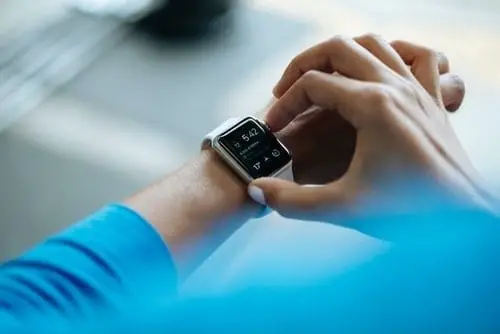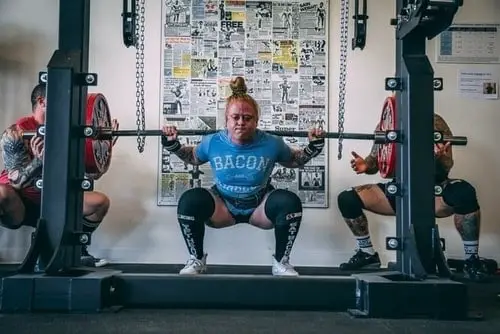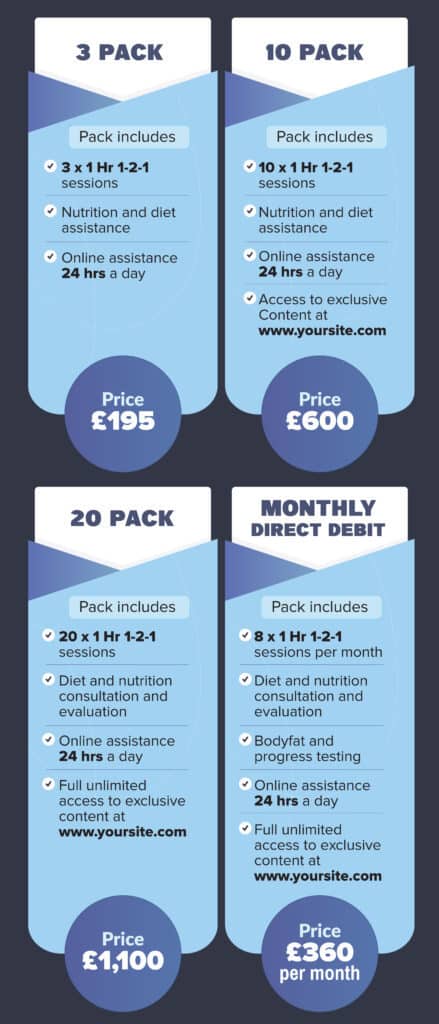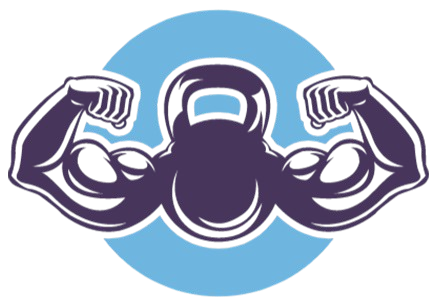Fitpro Income
Personal Training Consultation Sessions: Supreme Guide
Throughout my many years as a personal trainer, I have seen lots of techniques to gain new clients.
I’ve tried most of them, and there is one method that stands head and shoulders above the rest.
That method?
Giving out complimentary personal training consultation sessions.
In this article, I will be outlining the step-by-step process of booking complimentary personal training clients and showing you the techniques I used to convert 60% of my sessions into long-term personal training clients. I’ll then be giving you all the advice you need to show you how to do a personal training initial consultation, so you feel fully comfortable.
Let’s go!

A personal training consultation is an opportunity for someone that is considering taking up personal training to see what they can gain from hiring a PT. They will be asked about their fitness goals and if they have any injuries, then they’ll be taken through a brief sample training program.
This is going to be a chunky article with a lot of great information, so I’ll break it up a little to make it easier to use.
The definitive guide to personal training consultation sessions
- Pros and cons of consultation sessions
- Why you should offer consultation sessions
- Booking in consultation sessions
- Questions to ask before the consultation session
- Confirming the session is going ahead
- Creating your personal training package booklet
- Structuring the perfect complimentary session
- Questions to ask during a consultation session
- Questions to ask before the sales pitch
- Closing the sale
- How to handle the common objections that you will hear
- How to train people that can’t afford you
Pros and cons of consultation sessions
I loved giving complimentary personal training sessions because I converted so many of them into clients, but not everyone agrees.
There are personal trainers I met that were 100% against offering anything for free.
Nutrition advice, exercise advice, anything! They would demand people pay for it on the basis that their time was valuable, so why should they give it for free?
The common theme I found amongst these trainers was that they were not the busiest trainers in the gym.
Because I know that everyone has their own beliefs and opinions, I am going to list out a few of the pros and cons that I can see of giving complimentary personal training sessions so that you can make your mind up.
pssst (you should totally offer them)
Pros
- Allows you to demonstrate your knowledge of exercise techniques
- Gives you time to build rapport with your prospective client
- Allows you to sell your sessions whilst the client is still on their training “high”
- Lets you demonstrate how much more efficient and effective a session with a trainer can be
- Gives you time to build trust with your prospective client
- Gives you a more relaxed atmosphere to answer the prospects’ questions during a session
- Allows other gym members to see your training techniques and gets your face known
- Allows you to fill up any gaps in your training diary
- Gives the appearance of you being a “trainer in demand” if you are frequently seen, training people
Cons
- You must give away an hour of your time for free when you have gym rent to pay
- The gym member may not convert, so it could be a “waste of time” (it’s never a waste of time)
- The member may not turn up to the session
- Member may just use your time to get advice for free and then leave
- Less perceived value in things given for free
Why you should offer consultation sessions
You’ll notice from the list above that there are far more advantages than disadvantages to giving complimentary sessions.
I honestly tried to think of as many negatives as I could, but these are the ones that sprang to mind, and the reasons I found most PTs told me they wouldn’t offer them.
It really baffles me that so many personal trainers choose to not offer free sessions, they are such a good way of picking up clients.
There have even been situations where the person I trained didn’t want a PT but liked my training, so recommended their friend try it and they signed up.
That doesn’t sound like a waste of time to me.
Demonstrate your knowledge
Talking to a member on the gym floor or over the phone may be useful in a sense, but nothing competes with physically taking a member through one of your sessions.
You can explain the benefits and features of your training structure over the phone or in person, sure, but nothing beats a member experiencing it for themselves.
They can make a much more informed decision on whether they will want to carry on with you after feeling the effects rather than just hearing about it.
You would need to be seriously persuasive to make someone part with a substantial amount of cash and commit to you without ever giving them a taste of what you can offer them.
You can use touch cues, and explain what muscles are being used and how that particular exercise will help them reach their goals.
This shows the potential client that you have taken what they have told you into account and that you are giving them a truly “personal” session, not a one size fits all approach to your training.
You do not want to bombard them with complicated exercise physiology and technical terms they won’t understand.
This could potentially put them off training with you, but a sprinkling of knowledge spread throughout the session will build your potential clients’ confidence that you are the real deal and not just someone that needs more clients to fill up their diary.
Demo the importance of proper training technique

People may have been paying for memberships and coming to the gym three or four times a week for years before deciding to allow a trainer (you) to give them a hand.
During this time, they could have been training in a very inefficient way, even performing basic exercises incorrectly if they have not investigated the techniques correctly.
By showing them how to perform the exercises correctly by squeezing the muscle at the top of the contraction, using correct tempos, or ensuring the full range of motion is used, you can dramatically improve the quality of their workouts.
This is information they may have never ended up knowing and might have made them feel the gym was a waste of time and given up on it.
Another huge benefit you have is that people that work in cities tend to have lots of postural issues created by their work lives.
Here is your chance to shine by demonstrating your knowledge of exercises that will help them combat the effects of sitting in a chair all day.
By showing that you know how to not only prescribe exercises that will help people lose weight and grow muscle, but that will also help people correct postural issues that could cause otherwise permanent damage to their bodies through muscular imbalances.
You will sound more like a doctor than a bog-standard exercise coach!
I used to conduct a full postural assessment as part of my consultation sessions that explained their current imbalances and how we would be correcting them.
I considered myself (and still do) an exercise geek. I love learning about the body and its functions, so I liked to demonstrate my knowledge of anatomy to my clients.
This may not be for everyone, and if it’s not your style then that’s no problem, but what it does demonstrate, is that by giving complimentary sessions, you are giving yourself a stage to demonstrate all your expertise in a relaxed atmosphere that can be enjoyable for both parties.
Demonstrate what a time-efficient and effective workout feels like

People that train regularly may have a decent idea of how to structure their workouts to be time-efficient and get the most out of the hour or so they spend in a gym.
However, for many people, a trip to the gym consists of aimlessly moving from machine to machine with a little bit of half-hearted cardio at the end of their session.
You can show people how much can be achieved in a short time by structuring their exercise programs properly.
People give up on things when they don’t see any effect, and training with little to no structure is a sure-fire way of seeing no results.
These people would usually quit the gym after realizing that exercising “just doesn’t work for them”. Your sessions can show them that with a little bit of structure their goals can be achieved quickly, efficiently, and in a fun way too.
Booking in consultation sessions
Talking to members on the gym floor is difficult no doubt, you may feel very nervous if this is new to you and unfortunately it’s not something you get taught in your training courses, despite it being one of the most important factors of working as a personal trainer.
A great way to get over the anxiety of floor walking so that you can book in comp sessions is to do it.
You need to do it and do it, and do it again.
Walk the floor every hour that you don’t have a client, and do not let yourself leave the gym until you have hit a specific target of people talked to that day.
The first few days will feel difficult, but after some time, I promise you this will get easier and easier, and soon enough talking to members and getting them booked into a comp session with you will become effortless.
Walking the gym floor
Without having the confidence to walk the gym floor and pick up clients, you will not be able to get your complimentary sessions booked in at all.
There are other options of course, such as comp sessions that are offered by the gym upon joining, however, it is my experience that these tend to be the sessions that get the most “no shows” as they are less valued by the members.
When someone has taken the time and effort to speak to you, get to know you, and book a session, they are more likely to attend the session.
You have the guilt factor on your side.
Booking in a session

Not everyone is going to say yes to a complimentary session, not even with all your charm and charisma. Some people just don’t see the value, and that’s fine if they say no, move on to the next person.
You will face rejection multiple times in your career, and the more times you get rejected the less it will worry you.
I used to make a point of trying to see how many times in a day I would get rejected.
That seems silly but turning it into a game made it quite a fun experience.
Of course, with the techniques from the article listed above, you will face rejection less and less, but it’s good to build up a very thick skin as quickly as possible.
The most efficient way of booking a free personal training session with someone is to ask it with confidence.
If you begin by confidently asking the questions to your prospect but then start to flake when the issue of price arises, you will come across as nervous and unsure of yourself and the value of your services.
Nothing puts people off like a lack of confidence, so go in strong.
Go through the questions outlined in the article above and use the technique of a false time constraint, for example, “I’ve got a client in a second, but I’d love to discuss this more with you, can we book a session sometime next week?”.
This gives you the chance to ask the question with confidence because you know you won’t be hanging around if the conversation goes sour, but also shows that you are a busy trainer that already has clients.
You must go in for the kill with confidence!
Questions to ask before the consultation session
When going into a consultation, you’ve really got to be prepared, if you know nothing about the person you will be training, how are you going to write up a great program that makes them want to carry on training with you?
What if you spend two hours writing the greatest, most incredible program with all the “wow” factor a session could have, only for the client to turn up and let you know they have terrible lower back pain and a twisted ankle?
Then what? Everything goes out the window and you will be standing around thinking of what you can do, which automatically makes you look like you have no idea what you are doing.
Don’t do that, instead, ask plenty of questions beforehand so that you are fully aware of what your potential client can and can’t do, so you can write up that incredible session that takes into account any injuries or issues they have.
Common personal training consultation questions you should ask during your initial chat would include:
- Their main goals and objectives
- If they have ever trained with a trainer before
- Info on current or previous injuries/health issues which cause any discomfort or issues whilst training
- How long they have been training in general
- Do they do any additional exercise outside of the gym (weekend sports etc)
- Time preferences for training
- How many times per week they will be able to train either with you or on there or on their own
- What their current knowledge of nutrition is
The more information the better, if you have a ton of info on your prospect before you go into a training session with them you can prevent the very awkward situation of being totally stumped on what exercises to give them. I’ve seen it happen plenty of times before, and it’s like watching one of those dating shows where the two people have no idea what to say to each other.
Cringey…….but entertaining to watch!
Confirming that the session is going ahead
“No shows” are part and parcel of the personal training business I’m afraid.
There will be plenty of occasions where you are confident that a prospective client is going to come to the session that you booked, only to find they don’t show up. However, there is an easy way to lessen the chance of it happening to you.
Why not use those contact details again to confirm several times that the member will be attending the session?
I would recommend at least two confirmation emails or messages before your session is due to start.
One several days after your initial chat in the gym, and one on the day it is booked for.
This serves two important purposes.
Firstly, it lets you know if the member cannot make the session you arranged, which allows you to either re-book the session for another time or to move on to the next customer.
Secondly, you have the added guilt factor of the client not wanting to let you down after they have confirmed several times that they will be attending.
A lot of people will say yes to booking a session with you just to get rid of you so they can carry on with their workout, or because they feel awkward in that position, but may not initially be that interested in actually coming.
Reminding them that they have said yes to a session may just give them the nudge they need to attend, which gives you a chance to give them the best session of their lives and sign up for your sessions.
Creating your personal training package booklet
By creating your personal training package booklet, you give yourself a chance at marketing your services to the member in a highly professional and easy way.
This is one of those tips that you just don’t find anywhere else, and whilst going to the effort of writing up a personalized booklet may seem time-consuming, I can assure you it is absolutely worth every second.
What your personal training booklet should include
Everything that is included in this package is designed to sell your services and overcome your client’s objections before they even arrive at the complimentary session.
It should include the following information:
- Information about your experience and qualifications
- Why your training styles work and what’s different about them
- Previous client testimonials (if you’ve trained family members, you can use theirs)
- Previous clients’ transformation pictures
- Your pricing packages and benefits of each
Why the personal training package booklet works
You should immediately send a PDF version of your booklet to the member after you have agreed on a date for your session.
This gives your prospective client a chance to read the document in their own time without any pressure, acts as yet another reminder about the session, and shows that you are professional in the way that you conduct yourself as a trainer.
It is filled with reasons why they should choose you as their trainer, gives social proof by showing that you have had previous clients that have had great results with you, and more importantly shows them your prices ahead of time.
This is important because it mitigates any shock factor that may come when you discuss prices during your sales pitch.
When it came to my sales pitches, my prospects had already decided which of the three training packages they would prefer to go for.
This meant I never had to rely on “hard selling”, I just had to ask which of the three options seemed the best for them.
It takes away any awkwardness and makes what is probably one of the most stressful aspects of personal training a walk in the park.
Other trainers in your gym will struggle with this process, but you will no longer need to.
Having a huge advantage over other personal trainers is never a bad thing!
How to do a personal training consultation
I’ve seen plenty of trainers taking prospects out for their first session only to walk around the gym trying to find free equipment, and looking flustered when they can’t get on anything. This makes you look unprofessional and can lose you the sale in an instant.
It seems that zero planning has been considered after booking someone in for a session. Following the next few steps will help you avoid this.
Pre-screening your prospect
Jumping into a complimentary session is never a good idea as I have outlined above.
Never, and I repeat, never go into a comp session without a very thorough idea of what you plan to do.
If a prospect even catches a glimpse of disorganization in your training, you will lose the sale.
Creating a workout around your prospect’s likes and goals
So here it is, your chance to really show off your skills as a trainer.
Please don’t make the fatal error of thinking that a comp session should be all about destroying your client to the point where they are struggling to walk out the door.
While some might enjoy this style of workout, it will discourage far more people than it will impress, therefore damaging any chance you have of converting them into full-time paying clients.
Your complimentary sessions should include;
- A warmup where you get to casually chat to your prospect and explain what the workout will contain
- A combination of exercises that will both be new to the prospect and will allow you to demonstrate proper technique
- Use of equipment that may put the prospect out of their comfort zone
- A quick postural analysis to demo your ability to diagnose muscular imbalances (learn this if you don’t know)
- A stretching session that allows you to discuss how the session went
The workout is not just about showing someone an exercise, watching them finish, and then moving on to the next one.
You should include “touch cues” if your client is ok with you placing your hands on them (ask this before) so that you can properly demonstrate exercise technique and form.
You should explain which muscles are being worked, where they should feel it, and what benefit it is giving them.
This shows that you paid attention to the answers they gave to the pre-screening questions, their exercise likes and dislikes, and any injuries they have.
The tricky part?
All this needs to be completed in around 45 minutes, with 15 minutes spared towards the end for your sales pitch.
Don’t forget to look at your watch every few minutes to make sure you are not running short on time. The last thing you want to do is rush a sales pitch.
I can guarantee you it will not go well if you do this.
Building rapport during your session

A commonly overlooked aspect of personal training is the relationships that you build with your clients.
You get to know your clients better than some of their closest friends because as an outsider you can remain impartial.
I once trained a married couple in separate sessions, so it was interesting to hear both sides of an argument they had that week.
It’s a little difficult not to appear to favor one side in this situation, so I just agreed with both of them.
Nothing quite like sitting on the fence, is there?
During your session, you should make a great deal of effort to ask your prospect not just questions about exercise, as this can get a little dull for the prospect and can make you appear a little dull too.
Instead, you should be asking questions about the person and learning as much as you can about them.
Showing an interest in your prospect’s hobbies, work and family builds trust and rapport that will seriously help you when it comes to the time to ask for money to exchange hands.
Questions to ask during a consultation session

During your consultation session, you need to deliver excellent exercise instruction, show them exercises they have never seen before, and demonstrate your expertise on why you are performing them and how they are helping your potential client reach their goals.
This goes without saying, but what is even more important is establishing a strong rapport, strong enough so your prospective client likes you and learns about who you are.
People only buy from people they like, this is a well-known fact, so if you make little to no effort to get to know them, why should a person start paying you hundreds of pounds a month to train them.
You also have the opportunity to show how fun you can be and how enjoyable each session will be.
People love to talk, and they love to talk about themselves, so in between exercises and rest periods ask them questions like this to get to know them more;
- Whereabouts do you live?
- What do you do for work?
- How long have you worked there?
- How did you get into that industry?
- Do you get to travel much with your job?
- What are your hobbies outside of work?
- Do you play or watch any sports?
- Have you got any good holiday destination recommendations for me?
- How did your session go with your previous trainer? (if they said they had)
- Have you got any good film recommendations for me?
The idea here is that you are asking questions that are giving you a great deal about the person you are training.
By doing this, you are establishing rapport, but with that, you are more importantly establishing trust. People don’t buy from people they don’t like and don’t trust.
If you can make them like you by asking questions that show you care about them, and then establish trust by also giving away a bit of information about yourself, you have created a strong connection which will make them much more likely to buy from you.
Make sure you maintain this rapport through your entire time training with your clients, I continue to be friends with my ex-client several years after I finished training with them.
Questions to ask before the sales pitch
Once you’ve completed the initial consultation session you will need to have a sit-down chat with your prospect to sell the sessions.
I developed this list as it very cleverly makes the prospect sell Personal Training to themselves.
By asking this list, you will have the client telling you all the great things about personal training and overcoming their own objections for you. Let’s look into a few of those questions now:
- How did you find the session today?
- Was there anything new you enjoyed today?
- What was your favorite exercise we did today?
- Was this style of training something new to you?
- Do you think exercising in the way we did today will help you reach your goals faster?
- Is reaching your goals important to you?
- Do you think you would benefit from further coaching?
- Do you have enough time to train several times a week?
- Did you feel more confident in the gym whilst we were training today?
- Do you have any questions for me?
Some of these questions may seem very closed, which means that they only require a one-word answer.
In sales, you usually don’t want this, however, they are there for a very specific reason.
A question like “Is reaching your goals important to you?”, usually will give you a yes answer, and we want to get at least three “Yes’” before we go in for the close.

Let’s call it 500 shall we?”
Closing the sale
You can give the world’s greatest complimentary session, hands down THE best, and it won’t make a bit of difference if you screw up the sales pitch!
Harsh but true.
If you fumble around asking questions just to avoid asking the client to confirm they are signing up, you will show that you have little to no confidence.
You need to go into this sales pitch expecting the sale, this is sales 101.
Do not go into the pitch with the expectation that your client probably won’t buy, or might not be interested because a piece of kit was busy and you had to find another piece.

Don’t think like this!
After you have finished the stretching portion of your workout, sit the client down, never try to close the deal whilst both parties are standing up, as it can allow the client to turn around and leave.
When your prospect is sitting down with you, they are in a position where they are accepting that they will sit and listen to your sales pitch.
They would have to physically stand up and walk away, which is much more awkward than just turning around and saying that they need to go and get changed or are running late.
Trust me, I have tried closing sessions with clients sitting and standing, and much as it may seem like it wouldn’t make a difference, it makes a hell of a difference.
Remember, this guide is about using lots of small techniques that add up to getting your closing percentage up to 60%.
So,
Never try to close a sale with your prospect standing!
And
Never EVER be ashamed of your prices
This comes back down to the confidence required to close a deal effectively.
Your prices are the prices that you need to charge to cover your gym rent and make a living.
They are nothing to be either ashamed of or embarrassed about.
The issue of the price should not be anything to be concerned about anyway, as if you have used the method mentioned above, the prospect will have looked through your training package and already seen your prices, so nothing will shock them.
The amazing thing about your training package is that they will almost certainly have seen your prices before they attend the complimentary session.
If this is the case, then you know that despite seeing your prices, they still came to the session, which means you are going into the sales pitch with a very warm lead!
You will probably come across trainers in your gym that are charging less for their sessions, and this is great!
The client transformation pictures and testimonials are all you need to fully justify your prices, so if someone is charging less than you, it’s probably because they lack confidence or experience.
Let them charge less, they will have to do twice the work you will.
Work smart, not hard!
How to structure your package options to get easy sales
Your pricing structure should be based on four options.
- Intro pack – 3 sessions
- 10 pack – 10×1 hr sessions
- 20 pack – 20×1 hr sessions
- Direct Debit – 4x Monthly sessions
Here’s how you should display your package options in your pack.

For those paying attention, you will see we have done something very clever with this price presentation.
We are steering people away from the packages that give you the least sessions with your client, such as the 3 or 10 pk options.
And we are making the blocks of 20 or the direct debit sessions the most cost-effective options.
You want to retain your clients for as long as possible, and having your clients sign up for monthly sessions is the easiest way of doing so.
Direct debit sessions are the best and easiest sessions to sell, as they work out to be the cheapest option for your clients on a per session basis.
And…..
Monthly payments make it more likely that your client will get used to paying smaller amounts more regularly, rather than having to stump up a large amount of money in one go.
It’s far less of a commitment in financial terms for your client, but because they will almost certainly stay with you for several months.
you stand to make a far larger amount in the long run without having to ever sell another block of sessions to them.
For a truly in-depth analysis of creating the perfect personal training packages, take a look at my article below.
“How To Create, Price And Sell Personal Training Packages“
Prescribing exercise, not selling sessions
Your prospect may well have already made their mind up in terms of which sessions package they would prefer to start with.
Instead of just waiting for them to tell you which one they want, take the lead.
Direct the customer to the direct debit sessions by stating how much better of a deal it is for them.
You need to take control of the sales pitch here and again; you need to do so with absolute confidence.
I would recommend going through the post-session questions, then saying something along the lines of:
“Taking your goals and timeframes into consideration, I would recommend the direct debit sessions”
You are then free to explain the benefits of why you think that is their best option, but don’t talk too much.
A few sentences about why it would suit them best is all they need.
The next step is incredibly important!
DO NOT SAY ANYTHING ELSE!!
After making your recommendation, stop talking and look at the prospect in the eyes.
This forces the prospect to make a decision there and then, giving you the best opportunity to close a sale on that day.
Offer a guarantee
Understandably, people are very nervous about making a decision there and then.
It’s a lot of money, time, and dedication you are asking them to commit to.
Something that can really help neutralize a prospect’s concern is a guarantee.
Offer a 100% money-back guarantee if they are unhappy with your training or sessions.
You may be worried about people taking advantage of this and asking for their money back at the end of the sessions.
There is room for a little small print in your package explaining that the guarantee is only valid for the first two sessions, and any sessions that take place after these need to be paid for in full.
You will very rarely find that people will take you up on the offer of giving them their money back as long as you give them the best training and advice you can offer.
If you truly are a good personal trainer, you will very rarely have any complaints from your clients.
How to handle the common objections that you will hear
If only it were as easy as finishing a complimentary session and your new client handing you a cheque.
These are large amounts of money we are asking for, and much as your session may have impressed them, people are
always wary of giving away their hard-earned cash.
You will, and I repeat, will have objections to your sales pitch.
Fortunately, PTs and salespeople have been hearing these objections for decades, so here is a list of the most common
and how to overcome them.
“I need to think about it”
Is easily overcome by asking
“Is there anything that I can help clarify for you now?”,
This brings the client back “into the now”
and makes them more likely to choose an option there and then.
If they have legitimate questions, answer them and ask for the sale again once all concerns have been addressed.
“I don’t have the time”
If someone is truly interested in making a difference in their lives, they will make time for you. This is sometimes a ploy by the prospect to get them out
of the situation, they are in.
You can ask them what their schedules look like and see how many hours they have free in the week to see if it’s compatible with your diary.
You can also refer back to your guarantee by offering the client to try it for a few sessions, see how it goes with their schedule, and carry on if it
all works out ok.
“I need to talk to my spouse first, they handle the money”
I heard this one a lot, it’s easily overcome by asking what you think their spouse would say concerning them starting a training regime.
You could also offer to discuss any issues with their spouse or partner to alleviate any concerns or queries they have.
And again, your offer of a guarantee will help make them feel more comfortable about dedicating themselves to sessions, as if they sign up for sessions and find out it doesn’t work with their family life, they can cancel.
No problem!
You will hear more objections than this, but these are the main three that I used to get regularly.
Practice overcoming objections and learn to turn it into a game.
Wait for the objection and see how well you can overcome it.
With a little bit of practice, you will be able to overcome even the most obscure of objections.
How to train people that can’t afford you
When someone says they can’t afford your sessions; they are probably being genuine.
It takes a lot of courage to say something like that instead of making an excuse.
It’s a fact that some people would love to train with you but cannot afford to.
Does this mean that you shake their hand and say,
“Well, sorry about that, but you have a good day”
Absolutely not!
There is always something you can offer people in these situations, and why should they not be able to benefit from your help?
Create smaller package options for people with less time or less expendable income.
Offer things like online coaching, diet plans, program design, and anything that would make it easier for people that genuinely want your help to access your services as a personal trainer.
Conclusion
With the processes above, you should now find that you can convert 60% of your consultation sessions into paid personal training clients.
You need to follow the plan very carefully to reap the full rewards, however, following even a few of the tips outlined will certainly increase your conversion rate.
Turning personal training consultation sessions into paid clients is probably one of the hardest parts of a personal trainer’s career, the sessions themselves are the easy part.
Why not make it a whole bunch easier for yourself by following the process above that helped me sustain a very successful business for over eight years?
Go get ’em!
